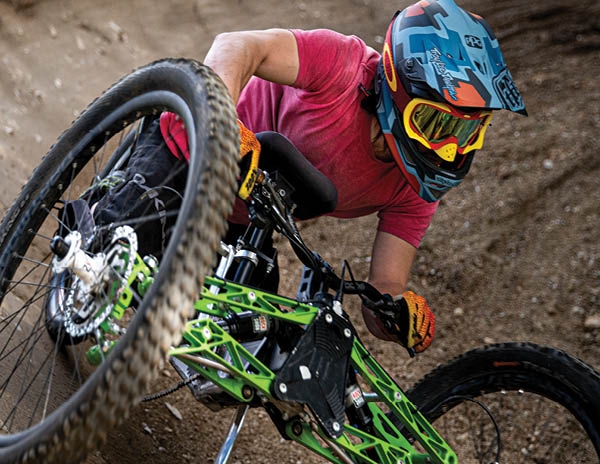In September 2022, the Mountain Bike Tourism Symposium (MBTS) brought together a hive of trail advocates to SilverStar Mountain Resort, B.C., for its biennial conference. There, trail builders, bike park managers, adaptive riders, indigenous groups, non-profits, economists, and risk assessors joined in discussion to address some of the most heated issues facing the mountain bike industry in a post-Covid world.
The symposium theme was “partnering for success,” and many of the topics discussed—sustainable operations, development, and community initiatives—are relevant to mountain resort bike park operators. Amid stark changes to consumer mindsets, climates, and cultural habits, a new way of thinking about mountain bike operations is emerging.
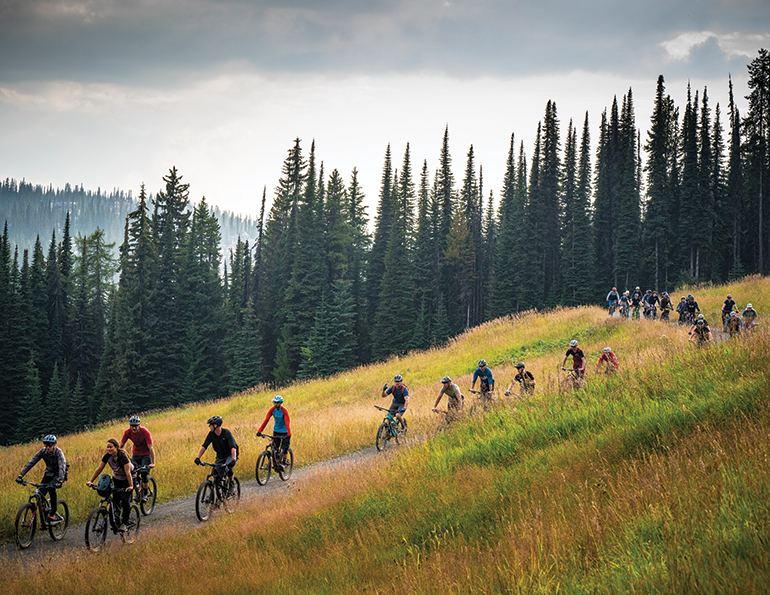 MBTS participants ride at SilverStar, B.C., after a day of community focused education sessions.
MBTS participants ride at SilverStar, B.C., after a day of community focused education sessions.
Here, we dive into some of the ideas expressed at MBTS to help you consider what a sustainable and vibrant future could look like at your own summer operation.
MITIGATING WILDFIRE RISK
Creating a sustainable mountain bike operation means addressing looming wildfire concerns, particularly for operators in the West. With frequent high fire danger levels that leave summer resorts at risk from something as trivial as a spark from a wrong pedal stroke or burning-hot disc brakes, proactive fire preparedness is essential.
Fire impacts. Wildfires can have a range of impacts on your infrastructure and operation, but what specifically happens to your bike trail network? “In most cases, these routes are not salvageable,” explained Matt Coté, a bike journalist who presented his research on trail recovery after wildfire at MBTS.
Coté’s research followed a handful of post-fire recovery efforts and noted that in all instances, brush grows back quickly, high-intensity fires change the physical makeup of soil, and erosion is a long-term threat, all of which make it hard to rebuild a trail. “Too much of the decomposed granite that makes up the trail bed gets compromised,” he explained in one example. “The only solution is to move over and rebuild in a new spot.”
Even then, recovery requires a coordinated—and complex—effort between numerous entities, including landowners, community organizations, indigenous tribes, bureaucratic agencies, and forestry advisers. With an active treatment plan, it can take upwards of five years to restore a burned trail and make it rideable again (and decades more to heal the landscape). It’s a costly process that has exhausted trail building crews.
Coté suggested it may be time for a collective shift in how people think about their trail networks. “We have to build trails with the idea of non-attachment and get away from the idea that if you build it one way, it needs to stay the way it is,” he said.
Fire mitigation. Unhealthy forests, invasive species, substantial fuel sources, and a lack of biodiversity are all factors that have proliferated the intensity and frequency of wildfires. Coté offered a starting point to managing these risks: work with the land. Controlled burns—including indigenous fire practices—native and drought-resistant landscaping, forest and underbrush thinning, and planting more biodiverse ecosystems are all key elements in mitigating fire risk and are well within our means.
“Resisting fire in the first place is how we got into this mess,” said Coté. “We need to coexist with [fire] and manage it in ways that make sense.”
For resorts that value their communities and structural investments, an immediate fire response plan is also essential. Any effective strategy requires seamless protocols that are easily executable across a large team.
Following a devastating fire season in 2003, Sun Peaks Resort, located in one of British Columbia’s most fire-prone regions, implemented a comprehensive fire plan that leveraged its own infrastructure, staff, local partnerships, and government aid. That plan includes:
• Basic fire suppression and safety (S-100) training each year for all outdoor operations staff, and resort-wide emergency training scenarios.
• Snowmaking equipment readied with smaller fittings that can accommodate forestry hoses and sprinklers.
• Water jugs strategically placed at the base of every lift tower should, e.g., a lit cigarette be discarded from a chairlift.
• Utilizing the bike park’s ATV—rigged with a 200-liter (53 gallon) water tank and used for daily trail maintenance—for easy mobilization in case of wildfire.
• A detection system that alerts certain staff via mobile app of a lightning strike within 30 km (18.6 miles).
• A strong partnership with the local municipality for tactical support from foresters and contractors who clear away heavy forest fuels.
“Our operations have been shut down from nearby wildfires a few times,” said Barney Mouat, Sun Peaks director of slopes and trails. “Everyone understands this is a real threat.”
ADAPTIVE ADVOCACY AND EDUCATION
Creating a unified mountain bike community requires trail access for a wide range of people. As Mike Riediger, CEO of Kootenay Adaptive Sport Association (KASA), explained, that starts with expanding adaptive mountain biking (aMTB) opportunities and infrastructure.
Adaptive trails do more than accommodate those with disabilities. “Accessible trails invite more age ranges, more kids, more skill levels, more socio-economic levels that transcend financial barriers, because you don’t need a super-expensive bike to have a great time,” said Riediger. “Everyone benefits from accessibility infrastructure—even those with a temporary and recoverable injury like a blown ACL.”
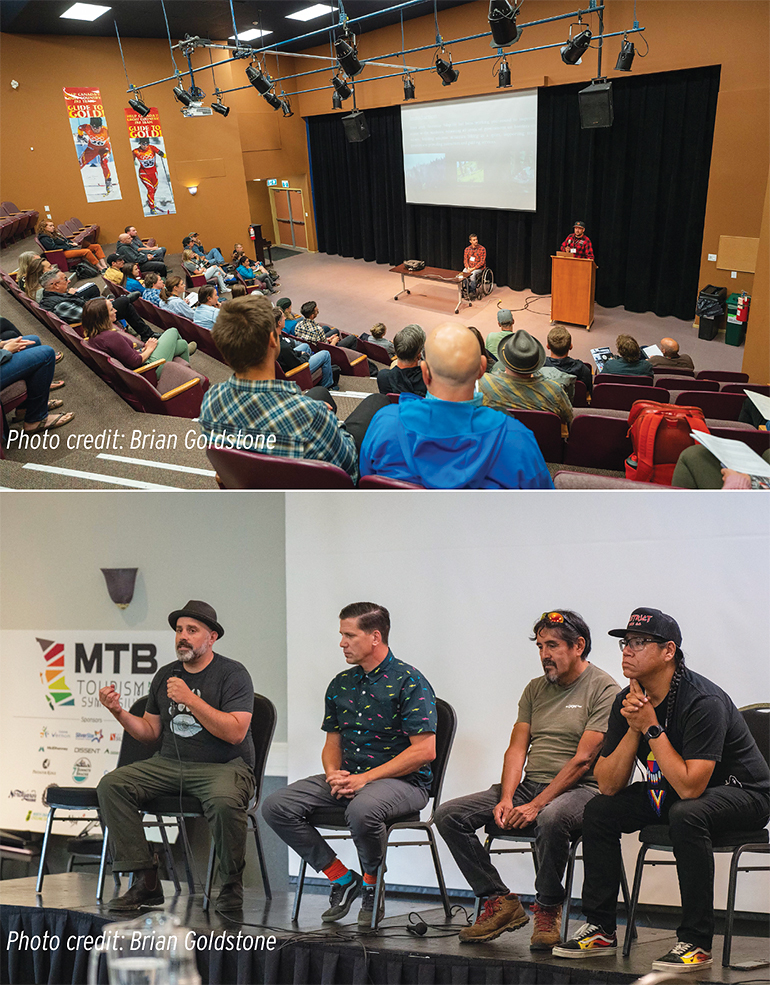 Top: Mike Riediger and Cam Lochhead discuss aMTB and the need for adaptive trails at MBTS. Bottom: MBTS panelists talk community responsibility.
Top: Mike Riediger and Cam Lochhead discuss aMTB and the need for adaptive trails at MBTS. Bottom: MBTS panelists talk community responsibility.
The time to start embracing that wider community is now. “Equipment advances have allowed for an ever-increasing number of [adaptive mountain bikers] to access the trails, and we are seeing more of these riders in the Whistler Mountain Bike Park—something we’re really excited about,” said Nick Voutour, Whistler Blackcomb public relations manager.
Simple adaptations. An entire trail system overhaul isn’t required to create an adaptive network; it simply begins with a conversation. “Work with an experienced adaptive rider to get a perspective on adapting existing trails and features,” Riediger encouraged. “Walk through existing trails and apply the adaptive standards to them. It might be easier to modify trails than you expect. Sometimes the only thing a trail needs is to remove one stump.”
In 2020, KASA, a British Columbia-based non-profit that advocates for aMTB programs, worked with athletes, builders, and allies to develop standards for aMTB trail development based on the functional limitations of disabled riders and their adaptive gear. The standards addressed needs like ample trail width, generous turning radii, double-wide areas for passing, and gentle grade reversals. [KASA aMTB trail standards: https://kootenayadaptive.com/adaptive-mountain-biking-trail-standards/.]
Whistler Blackcomb began implementing KASA’s recommendations prior to the Crankworx 2022 mountain bike festival with on-hill aMTB signage and is discussing more comprehensive trail descriptions with Trailforks, a trail database, map, and management system, to ensure adaptive riders aren’t getting into situations on-hill from which they can’t get out.
“After discussion with numerous stakeholders and aMTB experts, we collectively determined that lack of signage was a barrier to participation and one we could address quickly,” said Voutour.
Whistler Bike Park has also established training and protocols for lift operators and bike patrollers on how to work with adaptive riders and their gear, and it is anticipating the future inclusion of adaptive programming in the Whistler bike school. The resort also partners with Whistler Adaptive Sports, which provides cross country and trail riding programming beyond the bike park, contributing to the fast-growing aMTB community throughout Whistler.
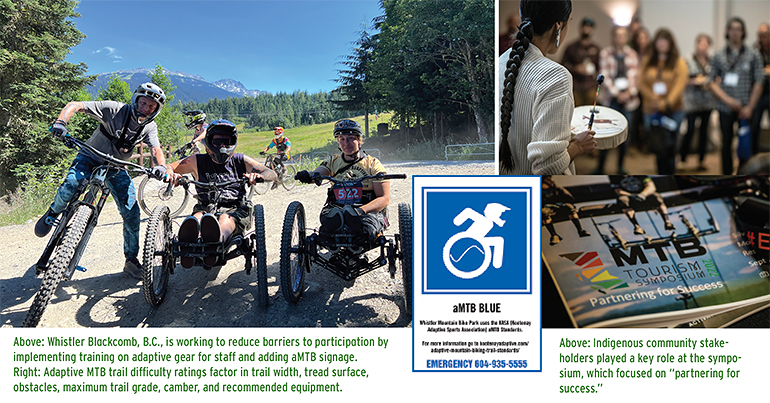
According to the Center for Disease Control and Prevention, roughly one in four American adults have a disability. To include this vast community in outdoor recreation and tourism invites economic and social opportunities that enable both individuals and businesses to thrive.
COMMUNITY BUY-IN
Gaining community buy-in for your mountain operation is no longer optional: it’s critical for establishing local support and trust. Mountain town residents are reaching their threshold for over-tourism and vocalizing their desire to be informed, involved, and invested in the decisions made by mountain destination leadership teams more than ever.
Building or repairing trust, said Ken Melamed, former Whistler municipality mayor and current volunteer trail builder, depends on a system of “social capital” that invites community conversation and participation.
“Resorts often exist as the main attractant in a community, and extending your peripheral beyond resort boundaries invites more collaboration and support with the greater community,” said Melamed. Translation: bonds with your neighbors are connective tissue that hold a community together.
Values alignment. But before plans or initiatives are made, it’s important to have a deep understanding of your organization’s values and ensure they align with the needs of your community, visitors, and other stakeholders. This will build the foundation that enables all individuals to interact positively, respectfully, and effectively.
It’s why SilverStar invited the Okanagan Indian Band to have a say in land usage and trail development, building a stronger relationship with its indigenous community. It’s why Fernie Alpine Resort has supported the Fernie Trails Association’s construction of a paved, multi-use connector trail through town, helping all groups of people get around easily without the need for a vehicle.
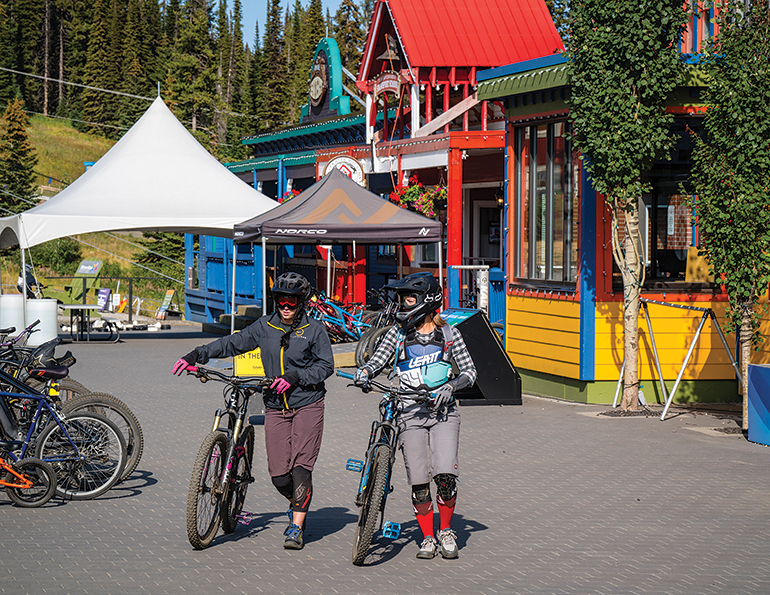 In between education sessions on sustainability, community building, and destination management, MBTS participants explored the trails and village at symposium host resort SilverStar, B.C.
In between education sessions on sustainability, community building, and destination management, MBTS participants explored the trails and village at symposium host resort SilverStar, B.C.
“People want to see a destination with an authentic passion for something,” said destination marketing strategist Andy Bethune. “When you put your energy into what your community is passionate about, the right people will follow.”
The flip side, Bethune added, can be detrimental: “If they aren’t aligned with your values, you’ll experience community rejection,” something that can destroy any potential for participation and trust.
“Resorts are just one part of the community mix,” explained Melamed, “and being involved in the mix is important for everyone. It’s as easy as starting a forum or brainstorm session and asking what kind of things you can participate in. There’s no limit to collaboration.”
Ultimately, there’s no one-size-fits-all solution when it comes to working with your community on your summer operations, but initiatives and partnerships are most powerful when they serve collective values. Guided by the right values, magic can happen; people and partnerships flourish, which, in turn, strengthens the community’s ecosystem and culture—the very fabric that shapes the success and sustainability of your business.





